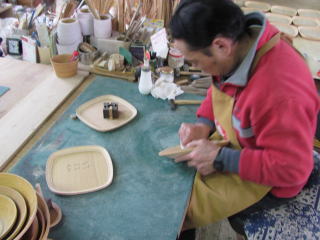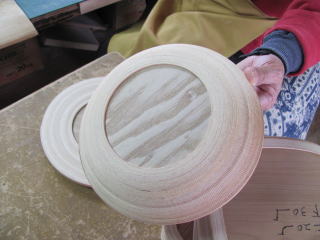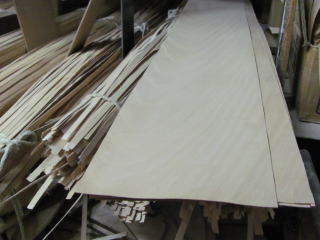Birth of BUNACO
半世紀ほど前(1956年)、青森県工業試験場・場長の城倉可成(しろくらかなり)氏と、石郷岡啓之介(いしごうおかひろのすけ)氏の共同研究により考案されたBUNACO。そのきっかけは、日本一の蓄積量を誇る青森県のブナを有効に活用することでした。そこで二人は、ブナの木を薄いテープ状にし、それを巻いて立体の物を形作るというアイデアを考え出します。この製法だと、従来の挽き物のような木の固まりを削る製法に比べて、製造過程で材料となる木材を無駄なく使うことができるのです。
The BUNACO was invented in 1956 by Mr. Kanari Shirokura, the director of Aomori Prefectural Industrial Research Institute, and Mr. Hironosuke Ishigooka, in collaboration with Mr. Keinosuke Ishigooka, in order to utilize the beech trees in Aomori Prefecture, which has the largest collection of beech trees in Japan, effectively. The two came up with the idea of making thin tapes of beech wood and wrapping them to form a three-dimensional object. With this method, the wood can be used more efficiently in the manufacturing process than with the traditional method of grinding a block of wood.
----製造工程----
Manufacturing process
1.ブナを薄い板にする
make a thin board of beech
大根のかつらむきのような方法でブナの木を厚さ1mm、長さ2mほどの薄い板にします。
The beech tree is made into a thin slab about 1 mm thick and 2 m long using a method similar to that of a radish wiggle.
2. テープ状にする
make a tape
薄くなった板を特殊な機械で幅1cmほどのテープ状にします。実際は商品によってテープの幅は異なるそうです。
テープ状になったブナ材は厚さや色によって分けられます。
A special machine is used to turn the thinned board into a tape about 1 cm wide. The width of the tape actually varies depending on the product.
The taped beech wood is classified according to its thickness and color.

3. 巻きつける
wrap it around
商品の底になる部分を芯として、テープ状のブナを巻きあげていきます。紙テープなどを芯に巻いていく要領で、見ていると簡単そうでが、「腕の力加減が非常に重要で、もはや職人技の域」と聞きました。出来上がりはまるでバウムクーヘンのようです。
ちなみに、24cm位のボウルを作るには32mほどのテープが必要になるそうです。
The bottom part of the product is used as the core, and the beech is rolled up in tape form. It's the same way as winding paper tape around a core, and although it looks easy, I've heard that "the degree of skill is very important, and it's a realm of craftsmanship". The result is just like Baumkuchen.
By the way, it is said that it takes about 32 meters of tape to make a 24 cm bowl.


4. 成型する
molding
ここまでは職人の方に作っていただきましたが、いよいよ体験メニューでチャレンジする工程に入ります。テープが巻きつけられたバウムクーヘン状のものに湯呑茶碗を使って、コイルの部分を押し出すように少しずつテープの巻き方をずらしながら立体を形作っていきましょう。
これまで、専用の道具を作って試してみたりもしたそうですが、結局、湯呑茶碗が一番使いやすいという結論に至り、今なお湯呑茶碗でブナコは形作られています。
We've had a craftsman make it up to this point, but now let's start the process of challenging it with the hands-on menu. Using a teacup, you can shape the coils of the baumkuchen-like object with the tape wrapped around it, shifting the way the tape is wrapped little by little as if to push out the coils.
He tried making special tools for this purpose, but eventually came to the conclusion that the teacup bowl is the easiest to use, and Bunaco is still being made with the teacup bowl.




5. 糊付け
gluing
成型された器に内側から液状の糊を塗ります。こうして糊が木材の中までしみこむことで、強度がぐっと増すのだそうです。
Liquid glue is applied to the molded vessel from the inside. The strength of the wood is greatly increased by allowing the glue to penetrate the wood.


6. 乾燥~研磨
drying and polishing
その後、乾燥室に入れて糊を乾かし、紙やすり等を使って表面を磨いていきます。
The glue is then placed in a drying room to dry and the surface is polished
with sandpaper or other tools.

7. 塗装
painting
最後に、塗装。ブナコは食器としても使えるよう、染料も安心安全なものを使用しています。オリジナルのブナコにも、商品と同じ塗装をしてもらえるので、ショールームに戻り、実際の商品を見ながら色を選んで終了です。
Lastly, painting.
We use safe and reliable dyes so that the Bunaco can be used as tableware. The original Bunaco will be painted to match the product, so you can go back to the showroom and choose a color while looking at the actual product.


